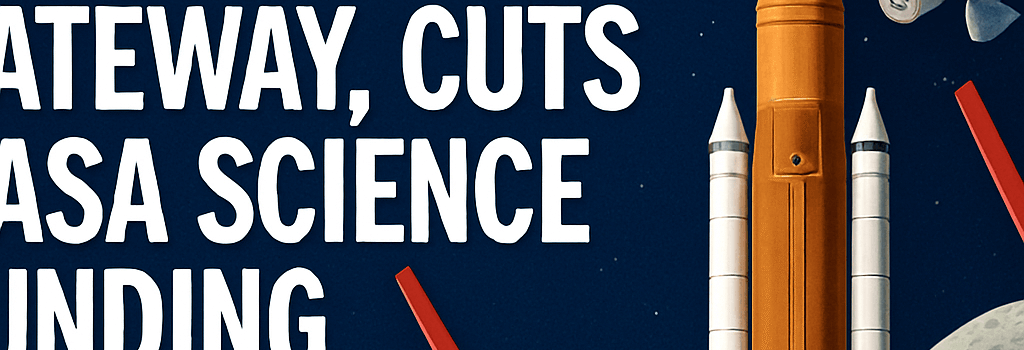Senate Backs SLS and Lunar Gateway, Cuts NASA Science Funding

US Senate Pushes Back on White House’s Fiscal 2026 NASA Request
As budget negotiations for fiscal year 2026 commence, the White House Office of Management and Budget (OMB) released its request on June 1, outlining a $27 billion ask for NASA. In contrast, the Senate Commerce Committee’s “legislative directives” provide early guidance ahead of appropriations markups, expected in late summer 2025.
The Trump administration proposed $3.91 billion for NASA science—down from $7.33 billion—while canceling flagship missions. Just days later, Senate Commerce Committee Chairman Sen. Ted Cruz (R-TX) published directives that sharply diverge on three fronts: science, the Lunar Gateway, and the Space Launch System (SLS) with Orion.
Senate Space Priorities vs White House
Science Budget: Deep Cuts vs Mars Sample Return Support
The administration’s request would defer or cancel several high-value missions:
- Europa Clipper delayed by 2+ years to reallocate $350 million.
- Landsat Next and PACE Earth-observation missions postponed, risking gaps in climate data continuity.
- Astrophysics Explorer programs scaled back to reduce $1.2 billion.
Cruz’s document remains silent on most cuts but explicitly calls for a Mars Telecommunications Orbiter. That satellite would host X-band (8 GHz) and Ka-band (32 GHz) transponders, enabling >200 kbps relay links between Mars rovers and NASA’s 34-m Deep Space Network antennas—an essential backbone for the Mars Sample Return campaign.
“A dedicated relay asset in Mars orbit is critical to guarantee high–throughput science data transfers,” says Dr. Laura Nguyen, telecommunications lead at JPL.
Lunar Gateway: Fully Funded ‘Critical Infrastructure’
Despite cost overruns on the Gateway’s Power and Propulsion Element (PPE) and habitation module (HALO), Cruz insists on full funding:
- HALO: 8 kW of life-support and avionics derived from ISS heritage systems.
- PPE: 60 kW solar arrays feeding Hall-effect thrusters for cis-lunar stationkeeping.
- Logistics module: using Cygnus and Dragon cargo flights for routine resupply.
Space Launch System & Orion: Beyond Artemis III
While the administration aims to sunset SLS and Orion after Artemis III, the Senate proposal extends funding through Artemis V:
- SLS Block 1B: Exploration Upper Stage boosts LLO payload from 27 to 38 t, with upgraded RS-25D engines.
- Advanced avionics: ML-based guidance, navigation, and control for precision lunar insertion.
- New solid rocket booster segments and on-pad inspection robots to reduce refurbishment time by 20 percent.
Comparing House and Senate Proposals
The House Appropriations Committee, led by Rep. Rosa DeLauro (D-CT), has already signaled a more science-focused budget, proposing a $150 million increase for Earth science. This sets up a potential conference stalemate:
- House: Prioritizes astrophysics and Earth science missions with ~8.7 percent budget growth.
- Senate: Emphasizes human exploration and heavy-lift vehicles; likely to attach policy riders restricting China collaborations.
- Conference: Will need to reconcile a ~$700 million gap between House science boosts and Senate’s deep cuts.
Technical Roadblocks and Budgetary Trade-offs
Maintaining each SLS launch at ~$2.5 billion exerts pressure on NASA’s procurement account, forcing tough trade-offs:
- RS-25 refurbishments vs. Starship Raptor reusability: Senate staffers question life-cycle costs.
- Gateway power demands exceed 40 kW; NASA is testing 30 percent-efficient multi-junction cells to reduce array mass.
- Scheduling on the Deep Space Network: adding a Mars relay asset may require a new 34-m antenna at Goldstone.
At a June 4 hearing, NASA Administrator Bill Nelson testified before the House Science Committee, warning that deferring four Earth-observing satellites would create a 15-year gap in critical climate data.
Implications for Commercial Partnerships
With Senate dollars funneled toward SLS and Gateway, commercial providers face an uncertain landscape:
- Starship lunar lander: excluded from Artemis IV/V funding despite 100+ t capacity and integrated ISRU prospecting capabilities.
- COTS-style fixed-price contracts may give way to cost-plus agreements for heavy-lift services, impacting private investment models.
- ISRU demonstrations at Shackleton Crater require stable policy signals to secure venture funding.
International Collaboration and Strategic Considerations
Amid China’s rapid CNSA advancements, the Senate frames space as a strategic domain:
- Gateway: ESA, JAXA, and CSA commitments total $2.3 billion in in-kind contributions.
- Export controls: new ITAR clauses proposed to protect deep-space navigation and comms tech.
- International Science Steering Committees to coordinate lunar geology and astrophysics payloads.
Next Steps: Budget negotiations will proceed through appropriations subcommittees; final allocations may hinge on a conference committee and risk government funding gaps if deadlines slip.
Expert Opinion: Dr. Jane Smith, planetary scientist at Caltech, warns, “Without robust Earth science funding, we risk critical data gaps in sea-level rise and atmospheric chemistry monitoring.”